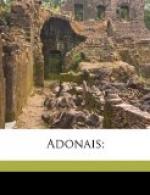11. 1-3. And she threw down Her kindling buds, as if she Autumn were, Or they dead leaves. This corresponds to a certain extent with the phrases in Bion, ‘the flowers are withered up with grief,’ and ’yea all the flowers are faded’ (p. 64); and in Moschus, ’and in sorrow for thy fall the trees cast down their fruit, and all the flowers have faded’ (p. 65). It may be worth observing that Shelley says—’As if she Autumn were, or they dead leaves’ (not ’and they dead leaves’). He therefore seems to present the act of Spring from two separate points of view: (1) She threw down the buds, as if she had been Autumn, whose office it is to throw down, and not to cherish and develope; (2) she threw down the buds as if they had been, not buds of the nascent year, but such dead leaves of the olden year as still linger on the spray when Spring arrives,
1. 4. For whom should she have waked the sullen Year? The year, beginning on 1 January, may in a certain sense be conceived as sleeping until roused by the call of Spring. But more probably Shelley here treats the year as beginning on 25 March—which date would witness its awakening, and practically its first existence.
11. 5-7. To Phoebus was not Hyacinth so dear, Nor to himself Narcissus, as to both Thou, Adonais; wan they stand and sere, &c. This passage assimilates two sections in the Elegy of Moschus, p. 65: ’Now, thou hyacinth, whisper the letters on thee graven, and add a deeper ai ai to thy petals: he is dead, the beautiful singer.... Nor so much did pleasant Lesbos mourn for Alcaeus,’ &c. The passage of Shelley is rather complicated in its significance, because it mixes up the personages Hyacinthus and Narcissus with the flowers hyacinth and narcissus. The beautiful youth Hyacinthus was dear to Phoebus; on his untimely death (he was slain by a quoit which Phoebus threw, and which the jealous Zephyrus blew aside so that it struck Hyacinthus on the head), the god changed his blood into the flower hyacinth, which bears markings interpreted by the Grecian fancy into the lettering [Greek: ai ai] (alas, alas!). The beautiful youth Narcissus, contemplating himself in a streamlet, became enamoured of his own face; and pining away, was converted into the flower narcissus. This accounts for the lines, ’To Phoebus was not Hyacinth so dear, nor to himself Narcissus.’ But, when we come to the sequence, ‘as to both thou, Adonais.’ we have to do, no longer with the youths Hyacinthus and Narcissus, but with the flowers hyacinth and narcissus: it is the flowers which (according to Shelley) loved Adonais better than the youths were loved, the one by Phoebus and the other by himself. These flowers—being some of the kindling buds which Spring had thrown down—stand ‘wan and sere.’ (This last point is rather the reverse of a phrase in Bion’s Elegy, p. 64, ’The flowers flush red for anguish.’) It may perhaps be held that the transition from the youths to the flowers, and from the emotions of Phoebus




